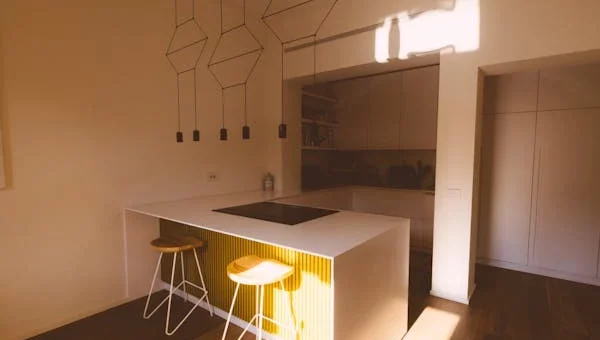
Introduction
Choosing the right lighting for your kitchen is crucial for both functionality and style. The kitchen is often the heart of the home, a space for cooking, socializing, and sometimes working. Proper lighting enhances the room’s aesthetics while ensuring safety and efficiency. This guide will walk you through everything you need to know to select the perfect kitchen lighting tailored to your needs.
Section 1: Understanding Kitchen Lighting Basics
1.1 Importance of Kitchen Lighting
Lighting plays a pivotal role in how your kitchen looks and functions. Poor lighting can make cooking hazardous and dining uninviting. Well-designed kitchen lighting improves visibility for food preparation, highlights design elements, and creates the desired ambiance.
Good kitchen lighting balances three key elements:
-
Functionality: Ensuring work areas are well lit.
-
Aesthetic Appeal: Complementing the kitchen’s design.
-
Energy Efficiency: Reducing energy consumption without sacrificing brightness.
1.2 Types of Kitchen Lighting
There are three main types of lighting to consider when planning your kitchen illumination:
-
Ambient Lighting: General illumination that lights up the entire kitchen evenly.
-
Task Lighting: Focused light for specific tasks such as chopping or reading recipes.
-
Accent Lighting: Decorative lighting used to highlight architectural features or decor.
Each type serves a different purpose and combining them effectively ensures a well-lit kitchen space.
Section 2: Assessing Your Kitchen Lighting Needs
2.1 Analyze Your Kitchen Layout
The layout heavily influences lighting requirements. Common kitchen layouts include:
| Layout Type | Lighting Considerations |
|---|---|
| Galley | Need focused task lighting for counters on both sides. |
| L-Shaped | Ambient lighting plus task lighting on counters. |
| U-Shaped | Balanced lighting for all three walls and island lighting. |
| Island | Pendant or chandelier lighting over the island is essential. |
Understanding your kitchen’s shape and focal points allows you to tailor your lighting plan for maximum efficiency.
2.2 Identify Key Functional Areas
Break your kitchen into zones to address different lighting needs:
-
Cooking area (stove, oven)
-
Preparation area (countertops)
-
Cleaning area (sink)
-
Eating area (dining nook or island seating)
Each zone might require a unique lighting solution, especially task lighting to enhance visibility and safety.
Section 3: Choosing the Right Fixtures for Your Kitchen
3.1 Ambient Lighting Options
Common ambient lighting fixtures for kitchens include:
-
Ceiling-mounted fixtures: Flush or semi-flush mounts that provide general illumination.
-
Recessed lighting: Installed in the ceiling, offers a clean look and widespread light.
-
Track lighting: Flexible and adjustable, ideal for highlighting multiple zones.
3.2 Task Lighting Solutions
For task lighting, consider:
-
Under-cabinet lights: Perfect for illuminating countertops where most prep work happens.
-
Pendant lights: Great over islands or breakfast bars for focused light.
-
Adjustable spotlights: Useful for targeting specific areas like the stove or sink.
3.3 Accent Lighting Ideas
Accent lighting can add personality and warmth:
-
Toe-kick lighting: LED strips under cabinets create a subtle glow.
-
Glass cabinet lighting: Showcase dishware with internal cabinet lights.
-
Above-cabinet lighting: Adds height and ambiance by illuminating the ceiling or walls.
Section 4: Selecting the Right Bulbs and Controls
4.1 Bulb Types and Color Temperature
The type of bulb impacts brightness, color, and energy use:
| Bulb Type | Brightness | Energy Efficiency | Color Temperature (Kelvin) | Ideal Use in Kitchen |
|---|---|---|---|---|
| LED | High | Very Efficient | 2700K-4000K (warm to cool) | General, task, accent lighting |
| CFL | Moderate | Efficient | 2700K-4100K | Ambient lighting |
| Halogen | Bright, crisp | Less efficient | 3000K-3500K | Task lighting |
| Incandescent | Warm, soft | Least efficient | 2700K | Accent lighting only |
Warmer tones (2700K-3000K) create a cozy atmosphere, while cooler tones (3500K-4000K) improve visibility for tasks.
4.2 Smart Controls and Dimmers
Integrating dimmers and smart lighting controls provides flexibility:
-
Dimmers: Adjust brightness for mood and energy savings.
-
Smart bulbs: Control lighting with apps or voice commands.
-
Motion sensors: Automatically turn lights on/off in busy kitchens.
Smart control enhances convenience and allows you to adapt lighting based on the time of day or activity.
Section 5: Styling Your Kitchen Lighting
5.1 Matching Lighting to Kitchen Design
Choose fixtures that complement your kitchen’s style:
-
Modern kitchens: Sleek, minimalist fixtures with clean lines.
-
Traditional kitchens: Classic chandeliers or pendant lights with decorative details.
-
Rustic kitchens: Warm-toned lighting with wrought iron or wood elements.
-
Industrial kitchens: Metal finishes and exposed bulbs.
5.2 Lighting Placement Tips
Correct placement ensures balanced lighting:
-
Install pendants 28-34 inches above the island surface.
-
Space recessed lights evenly, usually 4-6 feet apart.
-
Position under-cabinet lights to avoid casting shadows on work surfaces.
5.3 Incorporating Natural Light
Maximize daylight by:
-
Using sheer window treatments.
-
Positioning mirrors to reflect light.
-
Choosing light paint colors that enhance brightness.
Natural light works well with artificial lighting to reduce energy use and create a vibrant kitchen.
Conclusion: Illuminate Your Kitchen with Confidence
Choosing the right lighting for your kitchen is a blend of understanding your space, functionality, and personal style. By combining ambient, task, and accent lighting effectively, selecting suitable fixtures, bulbs, and controls, you create a kitchen that’s not only practical but inviting and beautiful.
What’s your kitchen lighting style? Share your favorite lighting ideas or questions below—let’s brighten up your kitchen together!